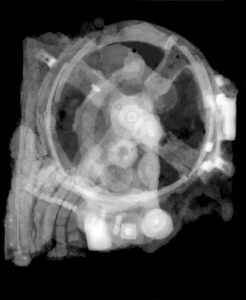According to research done on the device, it was used for “lunar and solar eclipses on the basis of Babylonian arithmetic-progression cycles.” -Tony Freeth
Incredibly Rare and Advanced Computer
Scientists believe that the ancient computer is from around the 2nd B.C. According to a study published in 2006 by the Nature academic journal this ancient greek computer was “technically more complex than any known device for at least a millennium afterwards.”
Today, this device is meticulously preserved in a National Archaeological Museum, Athens and is actually in 82 separate pieces. Some of the parts are inscribed with an ancient text which is believed to be the instructions for using the device.
The Antikythera Mechanism Research Project
In 2005 the Antikythera Mechanism Research Project was formed in order to uncover the mysteries of this greek device. Using Hewlett Packard and X-Tek System’s 3D technology they have been able to uncover many details about how the device functioned and how we could  even use its genius design to build one today.
even use its genius design to build one today.
One of the incredible X-ray technologies used to study the device was known as the ‘Bladerunner’. This technology can find details on artifacts that are impossible to see with the naked eye.
Because of the new X-Ray technique being used the 3,500 ancient Greek lettering on the Antikythera Mechanism can now be read according to CBS News.
“It was not a research tool, something that an astronomer would use to do computations, or even an astrologer to do prognostications, but something that you would use to teach about the cosmos and our place in the cosmos,” said New York University professor and researcher Alexander Jones.
“It’s like a textbook of astronomy as it was understood then, which connected the movements of the sky and the planets with the lives of ancient Greeks and their environment.”
“I would see it as more something that might be a philosopher’s instructional device.”
Check out what was discovered about the Antikythera Mechanism and how it functioned in the video below!
Sources- wikipedia.org — rt.com — ntikythera-mechanism.gr

